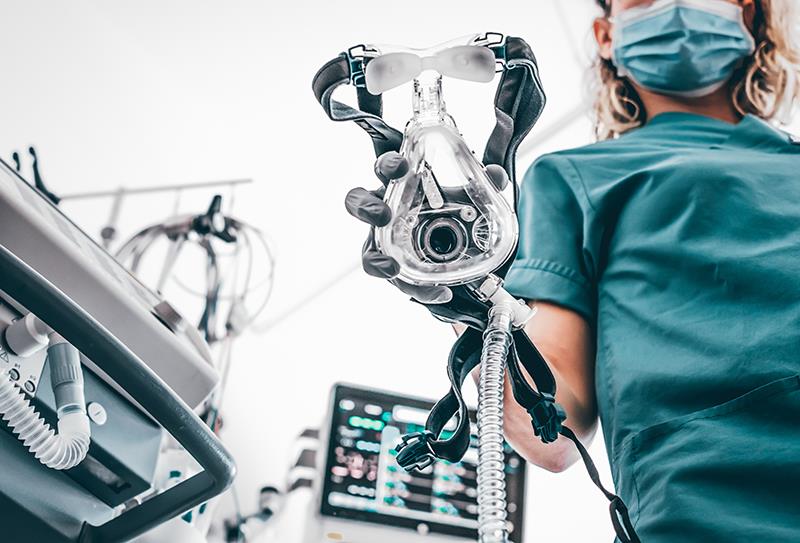Inhaled amikacin cuts VAP burden in mechanically ventilated patients

In critically ill patients who have been on invasive mechanical ventilation (IMV) for at least 3 days, a subsequent 3-day course of preventive inhaled amikacin reduced the burden of ventilator-associated pneumonia (VAP) during 28 days of follow-up, findings from the AMIKINHAL trial have shown.
At day 28, fewer amikacin recipients developed a first VAP episode as opposed to those on placebo (15 percent vs 22 percent; difference in restricted mean survival time to VAP, 1.5 days; p=0.004). “The first episode of VAP after randomization occurred at a median of 10 days after randomization in the amikacin arm and a median of 9 days in the placebo arm,” said the researchers.
Seven amikacin recipients developed trial-related serious adverse effects; with placebo, the corresponding number was four. [N Engl J Med 2023;389:2052-2062]
Key secondary outcomes
The incidence of a first VAP episode due to gram-negative bacteria susceptible to amikacin was lower in the amikacin vs placebo arm (7 percent vs 14 percent; difference in restricted mean survival time to VAP, 1.9 days).
Similarly, the amikacin arm had lower rates of ventilator-associated events than the placebo arm, such as ventilator-associated conditions (33 percent vs 40 percent; hazard ratio [HR], 0.79), infection-related ventilator-associated complications (18 percent vs 26 percent; HR, 0.66), and possible VAP according to ventilator-associated events definition framework (5 percent vs 10 percent; HR, 0.46).
VAP burden remains high
VAP is the most common manifestation of hospital-acquired lower respiratory tract infection, which affects intensive care unit (ICU) patients on IMV. [Am J Infect Control 2016;44:1495-1504; Euro Surveill 2018;23:1800516; Clin Infect Dis 2019;68:511-518] “VAP [has] an attributable mortality of up to 13 percent and contributes to increased systemic antibiotic consumption, duration of MV and ICU length of stay, and cost,” the researchers explained.
“Despite decades of research and implementation of preventive measures against VAP … the burden of VAP remains unacceptably high,” they stressed. Inhaled antibiotics facilitate delivery of very high antibiotic concentrations to the tracheobronchial tree, lung parenchyma, and tracheal-tube biofilm. [Ann Intensive Care 2017;7:78]
This investigator-initiated superiority trial comprised 850 critically ill adults (mean age 62 years, >60 percent men) who had been placed on IMV for at least 72 hours in 19 ICUs in France. “The enrolment of patients after at least 3 days of IMV may have enabled amikacin to act sufficiently early to control the tracheobronchial spread of bacteria before pneumonia occurred, with a majority of patients being extubated a few days after the end of the intervention and thus no longer at risk for VAP,” the researchers noted.
“Intervening earlier than the third day would increase patient exposure to preventive inhaled antibiotics, potentially increasing antibiotic-resistance selective pressure,” they explained. “[Thus,] this approach also provided a simple manner of selecting a patient population initially at high risk for VAP while avoiding exposure to preventive antibiotics among patients with short ventilation durations.”
Participants were randomized 1:1 to inhaled amikacin 20 mg/kg of ideal body weight QD or placebo for 3 days. According to the researchers, the 3-day preventive treatment course represented a compromise between efficacy and feasibility based on prior experience with inhaled amikacin and other forms of preventive antibiotics used in the ICU.
Over 80 percent of participants received all three daily nebulizations. A mean daily amikacin dose of 1,625 mg was nebulized over 47 minutes; for placebo, 13 mL of 0.9 percent sodium chloride was nebulized over 49 minutes. At the time of randomization, more than three-quarters of participants were receiving systemic antibiotics.





 Change Password
Change Password
 Points
Points
 Sign Out
Sign Out
